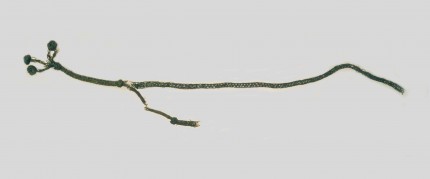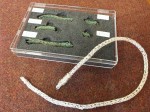 Archaeologists excavating Rufford Abbey, a country estate in Nottinghamshire, England, that was once a Cistercian monastery, have discovered the remains of a vicious-looking copper scourge. Nottinghamshire County Council community archaeologists were digging under a meadow on the property in 2014 when they saw a green stain in the soil. The stain surrounded pieces of wire copper strands that had been braided together in tubular form.
Archaeologists excavating Rufford Abbey, a country estate in Nottinghamshire, England, that was once a Cistercian monastery, have discovered the remains of a vicious-looking copper scourge. Nottinghamshire County Council community archaeologists were digging under a meadow on the property in 2014 when they saw a green stain in the soil. The stain surrounded pieces of wire copper strands that had been braided together in tubular form.
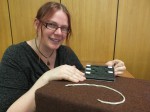 They weren’t certain what the fragments were, but archaeologists Emily Gillott and Lorraine Horsley thought it was reminiscent of a copper scourge unearthed in the dormitory area of the ruins of Rievaulx Abbey in Yorkshire. Testing of the artifact and consultation with experts has now confirmed that Gillot and Horsley were correct. It is one of only four monastic copper scourges known in Britain. The other three are at Rievaulx, Roche Abbey and Grovebury Priory. The exact date of manufacture and use is unknown, but it’s from the late medieval period.
They weren’t certain what the fragments were, but archaeologists Emily Gillott and Lorraine Horsley thought it was reminiscent of a copper scourge unearthed in the dormitory area of the ruins of Rievaulx Abbey in Yorkshire. Testing of the artifact and consultation with experts has now confirmed that Gillot and Horsley were correct. It is one of only four monastic copper scourges known in Britain. The other three are at Rievaulx, Roche Abbey and Grovebury Priory. The exact date of manufacture and use is unknown, but it’s from the late medieval period.
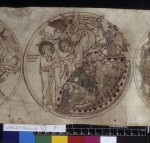 These were personal items, likely used in the privacy of a monk’s own cell. He would beat himself with the scourge in voluntary penance, to mortify his flesh for his sins and the sins of everyone he prayed for as Christ voluntarily sacrificed his body for the sins of mankind. There was a long and controversial tradition of self-flagellation in the Catholic Church, particularly in monastic life. St. Peter Damien introduced the practice as part of a new, stricter interpretation of the Rule of St. Benedict at the Camaldolese priory of Fonte Avellana in the 11th century. His self-flagellation rule was that it should be performed accompanied by the recital of psalms, 100 strokes of a leather thong on the bare back per psalm. The entire psalter would take 15,000 strokes to get through. Peter Damien suggested 40 Psalms and 4,000 stripes at a time should suffice, under normal circumstances, but the practice caught on like wildfire in the monastery and many monks outdid each other to pass that mark.
These were personal items, likely used in the privacy of a monk’s own cell. He would beat himself with the scourge in voluntary penance, to mortify his flesh for his sins and the sins of everyone he prayed for as Christ voluntarily sacrificed his body for the sins of mankind. There was a long and controversial tradition of self-flagellation in the Catholic Church, particularly in monastic life. St. Peter Damien introduced the practice as part of a new, stricter interpretation of the Rule of St. Benedict at the Camaldolese priory of Fonte Avellana in the 11th century. His self-flagellation rule was that it should be performed accompanied by the recital of psalms, 100 strokes of a leather thong on the bare back per psalm. The entire psalter would take 15,000 strokes to get through. Peter Damien suggested 40 Psalms and 4,000 stripes at a time should suffice, under normal circumstances, but the practice caught on like wildfire in the monastery and many monks outdid each other to pass that mark.
One of the monks at Fonte Avellana under St. Peter Damien’s leadership was St. Dominic Loricatus, whose moniker was a reference to the chain mail he wore next to his skin to torture himself harder than by wearing a mere hairshirt. He committment to self-flagellation was so extreme it seems impossible to be true. It got him a mention in Edward Gibbon The History of the Decline and Fall of the Roman Empire.
It is a maxim of the civil law, that whosoever cannot pay with his purse, must pay with his body; and the practice of flagellation was adopted by the monks, a cheap, though painful equivalent. By a fantastic arithmetic, a year of penance was taxed at three thousand lashes; and such was the skill and patience of a famous hermit, St. Dominic of the iron Cuirass, that in six days he could discharge an entire century, by a whipping of three hundred thousand stripes.
That’s 50,000 stripes a day. St. Peter Damien offered different figures in the biography he wrote of St. Dominic Loricatus. He said Loricatus did 12 Psalters without a break until he died of exhaustion in 1063. One Psalter = 15,000 lashes, so 12 = 180,000. Either way it’s horrifying, and that was with leather whip, not a copper one.
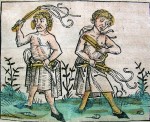 Self-flagellation became a regular part of monastic disciple for other rules as well, and spread far and wide during times of crisis, most notably when the Black Death tore through Europe in 1349. Flagellants would travel from city to city, naked from the waist up, whipping themselves while reciting psalms. They hoped their brutal public voluntary penance in imitation of Christ would persuade God to have mercy on the towns they visited and spare them from any further horrors of the plague. They probably helped spread it instead.
Self-flagellation became a regular part of monastic disciple for other rules as well, and spread far and wide during times of crisis, most notably when the Black Death tore through Europe in 1349. Flagellants would travel from city to city, naked from the waist up, whipping themselves while reciting psalms. They hoped their brutal public voluntary penance in imitation of Christ would persuade God to have mercy on the towns they visited and spare them from any further horrors of the plague. They probably helped spread it instead.
It’s possible that the copper scourges found in the English monasteries were used during the plague years as well. They’re certainly mean enough to suggest they were a response to a situation requiring extraordinary countermeasures.
